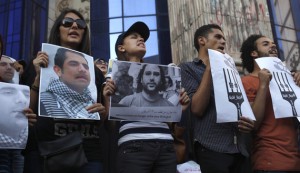In the article, “Egypt’s youth ‘have had enough’,” author Fouad describes the new revolutions that have arisen during Sisi’s presidency. The new campaign called “We have had enough” demands that anyone responsible for the murder of any Egyptians be held accountable. In addition, the group insists on a debate for the separation of powers, amendment of the protest law, implementation of human rights amendments, and setting minimum and maximum wages. Also, a new “Dhank” movement has been inspired by Sisi’s poor treatment of the lower class, which included removal of subsidies and raising prices of commodities. Youth groups remain suspicious of the state and feel their demands will likely not be met. There is no concrete strategy for ending the tension between youth groups and the state.
Blogger Sarah Moawad outlines the new wave of discontent in Egyptian politics in “Egypt’s ‘Poor Revolution’.” Egypt’s judicial system was recently scrutinized after refusing to reinstate state prosecutors who graduated from law school, but whose parents lacked university degrees. This ruling displays the institutionalized classism in Egypt that is causing a new uprising. The ruling is also a reason for the creation of the Dhank movement, which has been scrutinized because of suspicion of a connection to the Muslim Brotherhood. A leader of the movement warned that there could be a “revolution of the hungry” if the president ignores the people’s demands once again.
The events and movements outlined in these recent articles (October 2014) shows the unstable political culture in Egypt. Because protests and revolutions are the only way the youth leaders know how to get their demands met, they feel they must employ thousands of protesters in order to be heard by state leaders. It also shows the more discrete strategy of the Muslim Brotherhood to re-establish themselves into the political system in alignment with the population. Although these movements are not clearly organized, their structure can be compared to political groups with representatives. The leaders of these organizations represent a demographic of the population and attempt to enact change by publicizing their demands. If these leaders could have a viable role in the government, they may be able to please the most immediate demands of the population.

